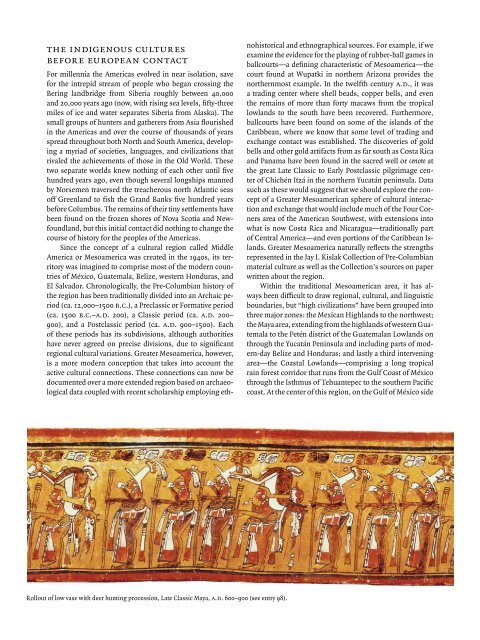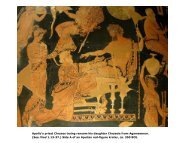Maya Flasks & Carlson Intro Kislak Catalog 2007
Maya Flasks & Carlson Intro Kislak Catalog 2007
Maya Flasks & Carlson Intro Kislak Catalog 2007
You also want an ePaper? Increase the reach of your titles
YUMPU automatically turns print PDFs into web optimized ePapers that Google loves.
the indigenous cultures<br />
before european contact<br />
For millennia the Americas evolved in near isolation, save<br />
for the intrepid stream of people who began crossing the<br />
Bering landbridge from Siberia roughly between 40,000<br />
and 20,000 years ago (now, with rising sea levels, fifty-three<br />
miles of ice and water separates Siberia from Alaska). The<br />
small groups of hunters and gatherers from Asia flourished<br />
in the Americas and over the course of thousands of years<br />
spread throughout both North and South America, developing<br />
a myriad of societies, languages, and civilizations that<br />
rivaled the achievements of those in the Old World. These<br />
two separate worlds knew nothing of each other until five<br />
hundred years ago, even though several longships manned<br />
by Norsemen traversed the treacherous north Atlantic seas<br />
o= Greenland to fish the Grand Banks five hundred years<br />
before Columbus. The remains of their tiny settlements have<br />
been found on the frozen shores of Nova Scotia and Newfoundland,<br />
but this initial contact did nothing to change the<br />
course of history for the peoples of the Americas.<br />
Since the concept of a cultural region called Middle<br />
America or Mesoamerica was created in the 1940s, its territory<br />
was imagined to comprise most of the modern countries<br />
of México, Guatemala, Belize, western Honduras, and<br />
El Salvador. Chronologically, the Pre-Columbian history of<br />
the region has been traditionally divided into an Archaic period<br />
(ca. 12,000–1500 b.c.), a Preclassic or Formative period<br />
(ca. 1500 b.c.–a.d. 200), a Classic period (ca. a.d. 200–<br />
900), and a Postclassic period (ca. a.d. 900–1500). Each<br />
of these periods has its subdivisions, although authorities<br />
have never agreed on precise divisions, due to significant<br />
regional cultural variations. Greater Mesoamerica, however,<br />
is a more modern conception that takes into account the<br />
active cultural connections. These connections can now be<br />
documented over a more extended region based on archaeological<br />
data coupled with recent scholarship employing eth-<br />
nohistorical and ethnographical sources. For example, if we<br />
examine the evidence for the playing of rubber-ball games in<br />
ballcourts—a defining characteristic of Mesoamerica—the<br />
court found at Wupatki in northern Arizona provides the<br />
northernmost example. In the twelfth century a.d., it was<br />
a trading center where shell beads, copper bells, and even<br />
the remains of more than forty macaws from the tropical<br />
lowlands to the south have been recovered. Furthermore,<br />
ballcourts have been found on some of the islands of the<br />
Caribbean, where we know that some level of trading and<br />
exchange contact was established. The discoveries of gold<br />
bells and other gold artifacts from as far south as Costa Rica<br />
and Panama have been found in the sacred well or cenote at<br />
the great Late Classic to Early Postclassic pilgrimage center<br />
of Chichén Itzá in the northern Yucatán peninsula. Data<br />
such as these would suggest that we should explore the concept<br />
of a Greater Mesoamerican sphere of cultural interaction<br />
and exchange that would include much of the Four Corners<br />
area of the American Southwest, with extensions into<br />
what is now Costa Rica and Nicaragua—traditionally part<br />
of Central America—and even portions of the Caribbean Islands.<br />
Greater Mesoamerica naturally reflects the strengths<br />
represented in the Jay I. <strong>Kislak</strong> Collection of Pre-Columbian<br />
material culture as well as the Collection’s sources on paper<br />
written about the region.<br />
Within the traditional Mesoamerican area, it has always<br />
been di



